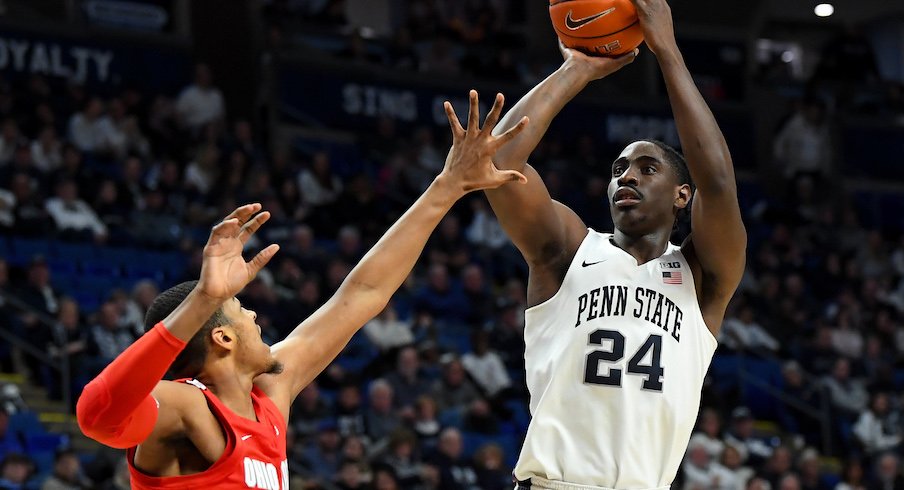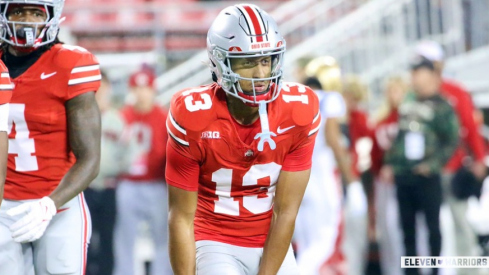Chris Holtmann didn’t need anybody to remind him of the statistic.
Standing just hallway taking him to the visiting locker room at Crisler Arena in Ann Arbor, Michigan, on Tuesday, he knew it off the top of his head. How could he not? Ohio State ranked – and still ranks – dead last in the Big Ten.
“I'm sure we're going to be 14th again in 3-point field-goal percentage defense,” Holtmann said. “They were 10-of-31. We'll be right back at the bottom there.”
He was right. Ohio State’s players and coaches woke up the next morning still ranked last in the Big Ten in 3-point defense.
It didn’t cost them that night, with Ohio State topping Michigan, 61-58. And it certainly is not the sole reason that this team has had such a turbulent past month and a half. Yet it’s a consistent issue that has seemingly only become more pervasive as the Big Ten season has progressed.
In Sunday’s 70-57 loss to Wisconsin, the issue popped up again. The Badgers hit 12-of-32 of their 3-point attempts (37.5 percent), including three consecutive triples in the final two minutes of the first half to turn a seven-point deficit into a 16-point deficit.
Was that Ohio State’s only problem in the 13-point loss? Of course not. It is, though, an issue that doesn’t get discussed too often yet has played a significant role in the Buckeyes’ defense not being nearly as stout as the team needs.
“We haven't defended the 3 as best as we had in the beginning of the season in the non-conference,” CJ Walker said a week ago. “I feel like that's one of the things that we have to improve on is to be able to make people take tough shots from 3, be over there to contest shots and things like that. I would just say awareness, whether it's ball-watching and things like that. Knowing who you're guarding, knowing where you're at on the floor and defensive rebounding. I feel like those are the two biggest things that we're getting better at. Just continue to build off that.”
What was once one of the top defenses in the country has steadily declined the past month and a half.
In non-conference games, the Buckeyes held teams to shoot 29 percent from 3-point range, the 33rd-best mark in the country. Along with a 2-point defense that allowed opponents to hit a nation-low 35.9 percent of their shots, Ohio State had both the No. 1 adjusted defensive efficiency (81.7) and No. 1 opponent effective field-goal percentage (38.7) in Division-I basketball.
Every defensive metric has fallen off a cliff since conference play began.
In the 14-team conference, the Buckeyes are 10th in adjusted defensive efficiency (95.9), 11th in opponent effective field-goal percentage (50.4) and ninth in opponent 2-point field-goal percentage (46.5). None of those numbers are quite as bad as Ohio State’s opponent 3-point field-goal percentage of 37.5 in conference games, which ranks last in the Big Ten.
Holtmann, asked a week ago whether 3-point defense has been poor or opponents have hit an unlikely amount of shots from behind the arc, had already seen enough evidence to convince him Ohio State needed improvement.
“I think it's definitely a combination of both, but I would air more on the side of we just have to figure out ways to contest and challenge better,” Holtmann said. “I do think some guys have made some timely 3s that maybe have not shot it well against other teams, but sooner or later, right, you've got to look inward and we've got to figure a way to contest and challenge better than what we're doing right now and to be more attuned to our assignments on that end. Some of it is we've been a little bit smaller on the perimeter. I think that's partly a factor. We played a little bit smaller on the perimeter. But yeah, that's a number that we've got to continue to address.”
If any Big Ten team wants to relocate a lost shooting stroke, apparently all it has to do is face Ohio State, a team that was supposed to have a stout defense but instead has gotten lit up from behind the arc within conference play.
Take a quick look at how each team the Buckeyes have faced in the Big Ten portion of their schedule has shot from 3-point range against them.
- Wisconsin (Feb. 9): 37.5 percent, the team’s No. 3 mark in 13 Big Ten games
- Michigan (Feb. 4): 32.3 percent, the team’s No. 6 mark in 12 Big Ten games
- Indiana (Feb. 1): 58.3 percent, the team’s No. 1 mark in 12 Big Ten games
- Northwestern (Jan. 26): 30.4 percent, the team’s No. 6 mark in 11 Big Ten games
- Minnesota (Jan. 23): 33.3 percent, the team’s No. 3 mark in 13 Big Ten games
- Penn State (Jan. 18): 47.4 percent, the team’s No. 1 mark in 12 Big Ten games
- Nebraska (Jan. 14): 40.9 percent, the team’s No. 2 mark in 12 Big Ten games
- Indiana (Jan. 11): 50 percent, the team’s No. 2 mark in 12 Big Ten games
- Maryland (Jan. 7): 44.4 percent, the team’s No. 1 mark in 12 Big Ten games
- Wisconsin (Jan. 3): 26.1 percent, the team’s No. 11 mark in 13 Big Ten games
- Minnesota (Dec. 15): 36.8 percent, the team’s No. 2 mark in 13 Big Ten games
- Penn State (Dec. 7): 34.5 percent, the team’s No. 7 mark in 12 Big Ten games
If it feels that teams are consistently shooting better than their season-long 3-point percentages indicate they should, it’s because that’s exactly what has happened.
In nine of 13 Big Ten games so far, Ohio State’s opponents have topped their average shooting percentage from behind the arc. Wisconsin was just the latest to take advantage of a growing flaw.


